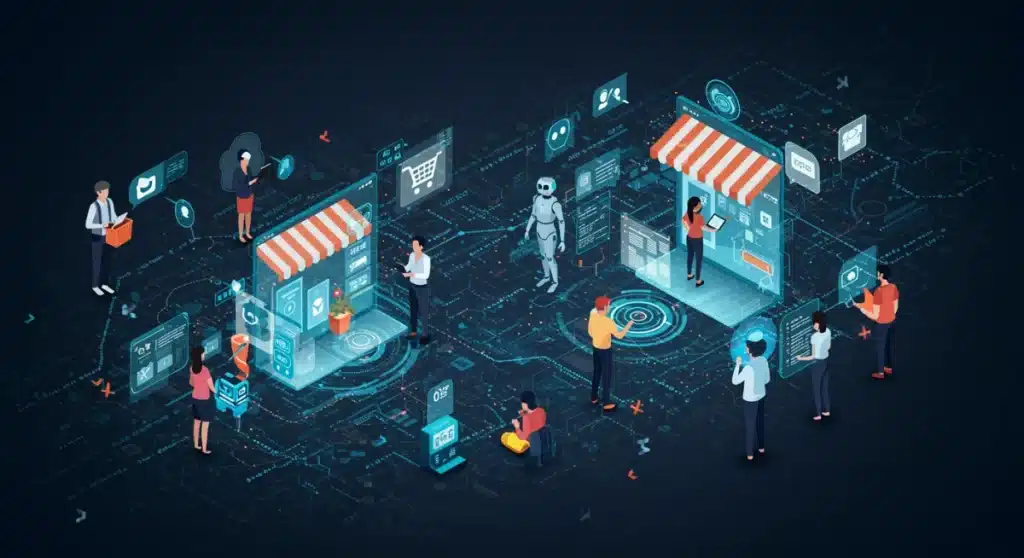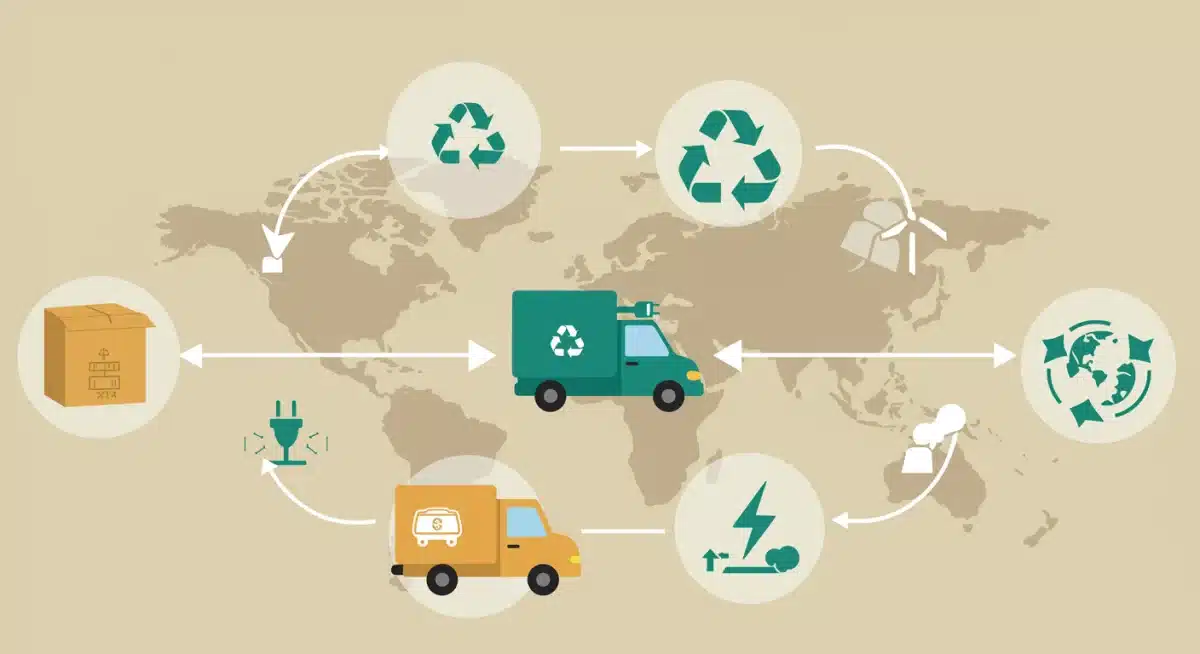Future of E-commerce: Key Trends Shaping Online Retail in 2025

The future of e-commerce is rapidly evolving, driven by innovations in AI, personalization, and sustainable practices, demanding that businesses adapt to new consumer behaviors and technological advancements over the next 12 months.
The Future of E-commerce: Key Trends Shaping Online Retail in the Next 12 Months is currently a focal point for businesses and consumers alike. As the digital economy continues its rapid expansion, understanding these shifts is critical for anyone looking to thrive in the online retail space. This report provides timely insights into what’s changing, why it matters, and what to monitor as these trends unfold.
AI and Hyper-Personalization Redefining Customer Journeys
Artificial Intelligence (AI) is no longer a futuristic concept but a present-day imperative shaping online retail. Over the next 12 months, its influence will intensify, moving beyond simple recommendations to create truly hyper-personalized customer journeys. This evolution means that every interaction, from product discovery to post-purchase support, is being tailored to individual preferences and behaviors, leveraging vast datasets to predict needs with remarkable accuracy.
The application of AI extends across the entire customer lifecycle, optimizing everything from website layout to marketing campaigns. Retailers are investing heavily in AI-driven tools that can analyze browsing history, purchase patterns, and even social media activity to offer a unique shopping experience. This level of customization fosters deeper engagement and significantly boosts conversion rates, making it a cornerstone for the e-commerce key trends.
Predictive Analytics for Inventory Management
- Demand Forecasting: AI algorithms analyze historical sales data, seasonal trends, and external factors like weather or news events to predict product demand with high precision. This minimizes overstocking and understocking, reducing waste and improving efficiency.
- Supply Chain Optimization: Predictive analytics enable retailers to anticipate supply chain disruptions and optimize logistics, ensuring products are available when and where customers want them. This is crucial for maintaining customer satisfaction and operational fluidity.
The integration of AI into personalization engines allows for dynamic content generation and real-time adjustments to product offerings. As a result, customers encounter a digital storefront that feels uniquely curated for them, enhancing satisfaction and loyalty. This sophisticated use of AI is a defining characteristic of the evolving online retail landscape.
The Rise of Immersive Shopping Experiences
Immersive technologies like Augmented Reality (AR) and Virtual Reality (VR) are poised to transform how consumers interact with products online. While still in nascent stages for many retailers, the next year will see significant advancements and broader adoption of these tools, allowing customers to visualize products in their own environments or experience them virtually before making a purchase. This trend directly addresses one of online shopping’s biggest challenges: the inability to physically interact with items.
AR applications, accessible via smartphones, are becoming increasingly sophisticated, enabling shoppers to try on clothes, place furniture in their homes, or even test makeup virtually. VR, though requiring more specialized hardware, offers deeper, more engaging experiences, particularly for complex or high-value products. These technologies are not just novelties; they are powerful tools for reducing returns and increasing buyer confidence, making them critical for the future of e-commerce.
Virtual Try-On and Product Visualization
Major brands are already experimenting with AR to allow customers to virtually try on clothing, accessories, and even experiment with different hairstyles or makeup shades. This enhances the shopping experience by providing a realistic preview, bridging the gap between physical and digital retail. According to a recent report by Shopify, businesses using AR for product visualization see a 94% higher conversion rate.
Beyond clothing, AR is proving invaluable for home goods and furniture. Customers can place virtual 3D models of items into their living spaces, checking for fit, scale, and aesthetic appeal. This reduces guesswork and significantly lowers the likelihood of returns, a costly issue for online retailers. The enhanced customer experience from these immersive tools is a driving force behind their adoption.
The increasing accessibility of AR/VR technology, coupled with consumer demand for more engaging online interactions, ensures that immersive shopping will be a significant aspect of e-commerce key trends in the coming months. Retailers who embrace these innovations will likely gain a competitive edge by offering a more comprehensive and satisfying shopping journey.

Sustainable E-commerce and Ethical Consumption
Consumer consciousness regarding environmental and social responsibility is reaching new heights, profoundly impacting online retail. Over the next 12 months, sustainable e-commerce practices and ethical consumption will transition from niche preferences to mainstream expectations. Brands that prioritize transparency, eco-friendly sourcing, and responsible logistics will resonate more deeply with consumers, particularly among younger demographics who are increasingly making purchasing decisions based on values.
This trend encompasses everything from sustainable packaging and carbon-neutral shipping to ethical labor practices in manufacturing. Retailers are now expected to not only offer quality products but also to demonstrate a commitment to planetary and social well-being. This shift is driving innovation in supply chains and marketing strategies, as companies seek to communicate their sustainability efforts authentically.
Eco-Friendly Packaging Solutions
- Reduced Plastic Use: Many retailers are moving away from single-use plastics, opting for biodegradable, compostable, or recycled materials for packaging. This includes innovative solutions like mushroom-based packaging and dissolvable films.
- Minimalist Design: Streamlining packaging to reduce material usage and shipping weight is another key strategy. This not only benefits the environment but can also lead to cost savings in logistics.
The push for sustainable e-commerce is also influencing product choices, with a growing demand for ethically sourced goods, fair trade products, and items made from recycled or upcycled materials. Brands that can effectively communicate their commitment to these values will build stronger trust and loyalty with their customer base, solidifying their position in the competitive online market.
The Evolution of Payment Systems and Fintech Integration
The way consumers pay for goods and services online is continuously evolving, with significant advancements expected in payment systems and fintech integration over the next year. The focus is on offering seamless, secure, and diverse payment options that cater to global preferences and emerging technologies. This includes the widespread adoption of digital wallets, buy now, pay later (BNPL) services, and even nascent explorations into cryptocurrency payments, all aimed at reducing friction at checkout.
Fintech innovations are enabling faster transaction processing, enhanced fraud detection, and more flexible financing options. For e-commerce businesses, providing a broad spectrum of payment methods is no longer a luxury but a necessity to meet customer expectations and minimize cart abandonment rates. This dynamic area is a crucial component of the e-commerce key trends.
Buy Now, Pay Later (BNPL) Dominance
BNPL services have seen exponential growth, particularly among younger consumers, offering interest-free installment plans. This payment model lowers the barrier to purchase for many, making higher-value items more accessible. Retailers integrating BNPL solutions often report increased average order values and higher conversion rates, according to industry data from Affirm and Afterpay.
The convenience and flexibility of BNPL make it an attractive option, and its presence is expected to become ubiquitous across online retail platforms. As competition in the BNPL space intensifies, we will likely see more tailored offerings and integrations directly within merchant platforms, streamlining the user experience even further.
Beyond BNPL, the continued rise of digital wallets like Apple Pay and Google Pay, along with the exploration of blockchain-based payment solutions, indicates a future where payment flexibility and security are paramount. E-commerce platforms must remain agile to integrate these new options and provide a frictionless checkout experience.
Social Commerce and Livestream Shopping Growth
Social commerce, the integration of e-commerce functionalities directly within social media platforms, is set for explosive growth over the next 12 months. This trend leverages the massive user bases and engagement dynamics of platforms like TikTok, Instagram, and Facebook to create direct purchasing pathways within the content consumers are already consuming. Livestream shopping, a key component of social commerce, is particularly gaining traction, offering an interactive and entertaining way to discover and buy products in real-time.
The appeal of social commerce lies in its ability to shorten the sales funnel, allowing impulse purchases and reducing the steps from discovery to conversion. Influencers and content creators play a pivotal role, turning their recommendations into direct sales opportunities. This blend of entertainment, community, and commerce is reshaping how brands connect with their audience and drive sales, making it a critical element of the e-commerce key trends.
Interactive Livestream Shopping Events
- Real-Time Engagement: Livestream shopping allows brands to demonstrate products, answer questions, and interact with customers in real-time. This creates a dynamic, engaging experience that mimics in-store shopping but with global reach.
- Influencer Collaboration: Partnering with popular influencers for livestream events can significantly boost reach and credibility, driving immediate sales through exclusive offers and interactive product showcases.
The data from platforms like TikTok Shop indicates a strong consumer appetite for purchasing directly within social media environments. Brands are increasingly allocating marketing budgets to social commerce initiatives, recognizing its potential to tap into highly engaged audiences. The seamless transition from content consumption to purchase is a game-changer for online retail.

First-Party Data Strategies and Customer Loyalty
In an increasingly privacy-conscious world, the reliance on third-party data is diminishing, pushing e-commerce businesses to prioritize first-party data strategies. Over the next 12 months, collecting, managing, and leveraging direct customer data will become paramount for building strong customer relationships and driving personalized marketing efforts. This shift is not just about compliance with evolving privacy regulations but also about fostering deeper trust and loyalty with consumers.
First-party data, gathered directly from customer interactions on a brand’s website, app, or through loyalty programs, provides invaluable insights into consumer behavior and preferences. Unlike third-party data, it is owned by the business and offers a more accurate, reliable, and ethical foundation for personalization and targeted marketing. This focus on direct relationships is a cornerstone of the evolving e-commerce key trends.
Building Robust Loyalty Programs
Effective loyalty programs are crucial for gathering first-party data and incentivizing repeat purchases. These programs offer exclusive benefits, personalized rewards, and early access to products, encouraging customers to share their preferences and engage more deeply with the brand. This direct exchange of value strengthens the customer-brand relationship and provides rich data for segmentation and personalization.
Beyond loyalty programs, strategies such as interactive quizzes, customer surveys, and direct feedback channels are becoming essential for collecting valuable first-party data. This data then fuels AI-driven personalization, ensuring that marketing messages and product recommendations are highly relevant and engaging, ultimately leading to higher customer lifetime value.
The ability to effectively manage and utilize first-party data will be a significant differentiator for e-commerce businesses. Those who master this will not only navigate the complex privacy landscape more effectively but also build more resilient and loyal customer bases, securing their future in the competitive online retail environment.
Key Trend |
Brief Description |
|---|---|
AI & Hyper-Personalization |
Tailoring customer journeys with AI-driven recommendations and dynamic content for unique experiences. |
Immersive Shopping |
Utilizing AR/VR to allow virtual product visualization, reducing returns and enhancing buyer confidence. |
Sustainable E-commerce |
Prioritizing eco-friendly packaging, ethical sourcing, and carbon-neutral logistics to meet consumer values. |
Social Commerce & Livestream |
Integrating shopping directly into social media platforms and interactive livestream events for direct sales. |
Frequently Asked Questions About E-commerce Trends
AI will empower small businesses by providing accessible tools for personalization, automated customer service, and optimized inventory management. This levels the playing field, allowing smaller players to offer sophisticated experiences previously exclusive to larger corporations, making it a critical aspect of e-commerce key trends.
While high-end VR still requires investment, AR applications are increasingly accessible and often smartphone-based. Many platforms now offer integrated AR tools, making it more affordable for businesses of all sizes to implement, fostering broader adoption in the evolving retail landscape.
Consumers prioritize transparency in sourcing, eco-friendly packaging, and ethical labor practices. They seek brands that genuinely commit to reducing environmental impact and contributing positively to society, influencing purchasing decisions significantly, which is a major part of e-commerce key trends.
Beyond BNPL, expect further integration of digital wallets, biometric payments, and potentially more mainstream adoption of cryptocurrency options. The focus remains on speed, security, and offering diverse choices to cater to a global customer base and emerging preferences.
Influencers are central to social commerce, driving discovery and direct sales through authentic recommendations and interactive content. Their ability to connect with niche audiences and build trust makes them powerful catalysts for impulse purchases and brand engagement within social platforms, a key aspect of e-commerce key trends.
Looking Ahead: Navigating the Evolving Digital Economy
The next 12 months will be a period of significant transformation for online retail, driven by these pivotal e-commerce key trends. Businesses must remain agile, proactively embracing AI, immersive technologies, and sustainable practices to meet evolving consumer expectations. The shift towards first-party data and the explosion of social commerce underscore the importance of direct customer engagement and value-driven propositions. Staying attuned to these developments and adapting strategies accordingly will be crucial for securing a competitive edge and fostering long-term growth in the dynamic digital economy.





